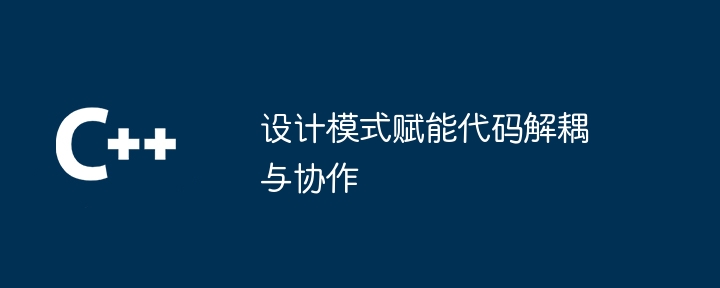Home >Backend Development >C++ >Design patterns empower code decoupling and collaboration
Design patterns empower code decoupling and collaboration
- 王林Original
- 2024-05-09 13:03:011124browse
Design patterns are standardized solutions designed to improve the maintainability and scalability of code in large projects. By understanding and using these patterns, developers can: Solve common programming problems and focus on business logic. Categories include creational, structural and behavioral patterns. The Strategy pattern example shows how to dynamically select an algorithm to handle different strategies for the same operation. Adopting design patterns helps create decoupled, maintainable, and extensible code and improves collaboration efficiency.

Design patterns empower code decoupling and collaboration
In large software projects, code decoupling and collaboration are crucial. Design patterns provide a standardized and reusable solution that can greatly improve the maintainability and scalability of code.
Understanding Design Patterns
Design patterns are a set of universal, proven solutions to common programming problems. They define the interaction of objects and classes in an unambiguous and repeatable way. By using design patterns, developers can focus on business logic without having to repeatedly solve common problems.
Classification of design patterns
Design patterns are mainly divided into three categories: creative, structural and behavioral:
- Creative mode: Used to create objects and control the creation process of objects. Such as singleton mode and factory mode.
- Structural pattern: Used to organize objects and combine objects to form higher-level structures. Such as bridge mode and combined mode.
- Behavioral pattern: Used to represent the communication methods and interactions between objects. Such as observer pattern and strategy pattern.
Practical case: Using strategy mode to implement polymorphic printing
Strategy mode provides a method of dynamically selecting algorithms. It allows developers to use different strategies to handle the same operation without modifying the caller code.
class Printer:
def __init__(self, strategy):
self.strategy = strategy
def print(self, input):
return self.strategy.print(input)
class TextPrintingStrategy:
def print(self, text):
return text
class HtmlPrintingStrategy:
def print(self, html):
return f'<div>{html}</div>'
# 使用文本打印策略
text_printer = Printer(TextPrintingStrategy())
print(text_printer.print("Hello World!")) # 输出:Hello World!
# 使用 HTML 打印策略
html_printer = Printer(HtmlPrintingStrategy())
print(html_printer.print("<p>Hello World!</p>")) # 输出:<div><p>Hello World!</p></div> In this example, the strategy pattern allows us to print input using different printing strategies (text or HTML) without changing the Printer class or caller code.
Summary
By using design patterns, developers can create highly decoupled and maintainable code. Patterns provide proven solutions that increase collaboration efficiency, reduce errors, and enhance code readability. As the complexity of projects continues to increase, the adoption of design patterns becomes critical to ensure the stability and scalability of software systems.
The above is the detailed content of Design patterns empower code decoupling and collaboration. For more information, please follow other related articles on the PHP Chinese website!

